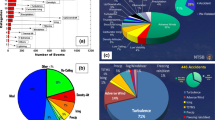Abstract
Thunderclouds act as the sources of energetic radiation, the main components of which are gamma particles and electrons. The radiation can be registered by satellite or ground-based detectors. The effect is caused by the bremsstrahlung of electrons accelerated by the cloud electric field. The study of high-energy atmospheric phenomena requires analyzing the data on the distribution of cloud particles and the electrical structure formed by them. In this study, the comparison of the information on meteorological conditions for energetic emission from thunderclouds obtained from satellite observations in the infrared and optical ranges is performed.


Similar content being viewed by others
REFERENCES
J. R. Dwyer, D. M. Smith, and S. A. Cummer, “High-energy atmospheric physics: Terrestrial gamma-ray flashes and related phenomena,” J. Space Sci. Rev. 173, 133–196 (2012).
A. Chilingarian, “Thunderstorm ground enhancements - model and relation to lightning flashes,” J. Atmos. Solar-Terr. Phys. 107, 68–76 (2013).
G. J. Fishman et al., “Discovery of intense gamma-ray flashes of atmospheric origin,” Science (Washington, DC, U. S.) 264 (5163) 1313–1316 (1994).
A. Chilingarian, A. Avetisyan, G. Hovsepyan, T. Karapetyan, L. Kozliner, B. Sargsyan, and M. Zazyan, “Origin of the low-energy gamma ray flux of the long-lasting thunderstorm ground enhancements,” Phys. Rev. D 99, 102002 (2019).
P. Klimov et al., “Remote sensing of the atmosphere by the ultraviolet detector TUS onboard the Lomonosov satellite,” Remote Sens. 11, 2449 (2019).
S. V. Biktemerova et al., “First results of the Lomonosov TUS and GRB experiments,” in Proceedings of the 25th European Cosmic Ray Symposium, Turin,2016.
C. T. R. Wilson, “The acceleration of beta-particles in strong electric fields such as those of thunderclouds,” Proc. Cambridge Phil. Soc. 22, 534–538 (1925).
A. V. Gurevich and K. P. Zybin, “Runaway breakdown and electric discharges in thunderstorms,” Phys. Usp. 44, 1119–1140 (2001).
A. V. Gurevich, G. M. Milikh, and R. A. Roussel-Dupre, “Runaway electron mechanism of air breakdown and preconditioning during a thunderstorm,” Phys. Lett. A 165, 463–468 (1992).
S. Eidelman et al., “Review of particle physics,” Phys. Lett. B 592, 1–1109 (2004).
A. V. Gurevich, K. P. Zybin, and R. A. Roussel-Dupre, “Lightning initiation by simultaneous effect of runaway breakdown and cosmic ray showers,” Phys. Lett. A 254, 79–87 (1999).
V. A. Rakov and M. A. Uman, Lightning: Physics and Effects (Cambridge Univ. Press, Cambridge, U.K., 2003).
M. Stolzenburg and T. C. Marshall, “Charge structure and dynamics in thunderstorms,” Space Sci. Rev. 137, 355–372 (2008).
D. M. Smith, B. J. Hazelton, B. W. Grefenstette, J. R. Dwyer, R. H. Holzworth, and E. H. Lay, “Terrestrial gamma ray flashes correlated to storm phase and tropopause height,” J. Geophys. Res. 115, A00E49 (2010).
http://wwlln.net/.
S. Mallick, V. A. Rakov, T. Ngin, et al., “Evaluation of the WWLLN performance characteristics using rocket-triggered lightning data,” in Proceedings of the Green Electronics Conference ICGE and 6th International Conference on Low Power Electronics ICLPE, Manaus, Brazil, May,2014.
E. H. Lay, R. H. Holzworth, C. J. Rodger, J. N. Thomas, O. Pinto, and R. L. Dowden, “WWLL global lightning detection system: Regional validation study in Brazil,” Geophys. Res. Lett. 31, L03102 (2004).
M. E. Splitt, S. M. Lazarus, D. Barnes, J. R. Dwyer, H. K. Rassoul, D. M. Smith, B. Hazelton, and B. Grefenstette, “Thunderstorm characteristics associated with RHESSI identified terrestrial gamma ray flashes,” J. Geophys. Res. 115, A00E38 (2010).
A. Tiberia, S. Dietrich, F. Porc?gu, M. Marisaldi, A. Ursi, and M. Tavani, “Gamma ray storms: Preliminary meteorological analysis of AGILE TGFs. Meteorology of AGILE TGF observations,” Rend. Lincei, Sci. Fis. Nat. (2019).
D. E. Barnes, M. E. Splitt, J. R. Dwyer, S. Lazarus, D. M. Smith, and H. K. Rassoul, “A study of thunderstorm microphysical properties and lightning flash counts associated with terrestrial gamma-ray flashes,” J. Geophys. Res. Atmos. 120, 3453–3464 (2014).
T. Chronis, M. Briggs, G. Priftis, V. Connaughton, J. Brundell, R. Holzworth, S. Heckman, S. McBreen, G. Fitzpatrick, and M. Stanbro, “Characteristics of thunderstorms that produce terrestrial gamma-ray flashes,” Bull. Am. Meteor. Soc. 2016, 639 (2016).
C. P. R. Saunders, H. Bax-Norman, C. Emersic, E. E. Avila, and N. E. Castellano, “Laboratory studies of the effect of cloud conditions on graupel/crystal charge transfer in thunderstorm electrification,” Quart. J. R. Meteor. Soc. 132, 2653–2673 (2006).
S. Lee, B. H. Kahn, and J. Teixeira, “Characterization of cloud liquid water content distributions from CloudSat,” J. Geophys. Res. 115, D20203 (2010).
http://crd.yerphi.am/adei.
A. Chilingarian, A. Daryan, K. Arakelyan, A. Hovhannisyan, B. Mailyan, L. Melkumyan, G. Hovsepyan, S. Chilingaryan, A. Reymers, and L. Vanyan, “Ground-based observations of thunderstorm-correlated fluxes of high-energy electrons, gamma rays, and neutrons,” Phys. Rev. D 86, 072003 (2010).
E. Svechnikova, N. V. Ilin, and E. A. Mareev, “Recovery of electrical structure of the cloud with use of ground-based measurement results,” in Proceedings of TEPA-2018 Conference.
www.mmm.ucar.edu/weather-research-and-forecasting-model.
A. Chilingarian and H. Mkrtchyan, “Role of the Lower Positive Charge Region (LPCR) in initiation of the Thunderstorm Ground Enhancements (TGEs),” Phys. Rev. D 86, 072003 (2012).
Meteosat. https://eumetview.eumetsat.int/mapviewer/.
ACKNOWLEDGMENTS
We are grateful to A.A. Chilingaryan for our fruitful discussions and providing access to the data array of the Aragats Scientific Station and A.A. Nozik for help in preparing this paper.
Funding
This work was supported by the Russian Foundation for Basic Research, project no. 18-05-80077 (investigation of the meteorological characteristics of TGEs) and the Russian Science Foundation, project no. 19-17-00218 (systematization of the information on the meteorological parameters of TGFs).
Author information
Authors and Affiliations
Corresponding author
Additional information
Translated by E. Smirnova
Rights and permissions
About this article
Cite this article
Svechnikova, E.K., Ilin, N.V. & Mareev, E.A. Meteorological Characteristics of Energetic Atmospheric Phenomena. Phys. Part. Nuclei Lett. 17, 840–847 (2020). https://doi.org/10.1134/S1547477120060102
Received:
Revised:
Accepted:
Published:
Issue Date:
DOI: https://doi.org/10.1134/S1547477120060102




